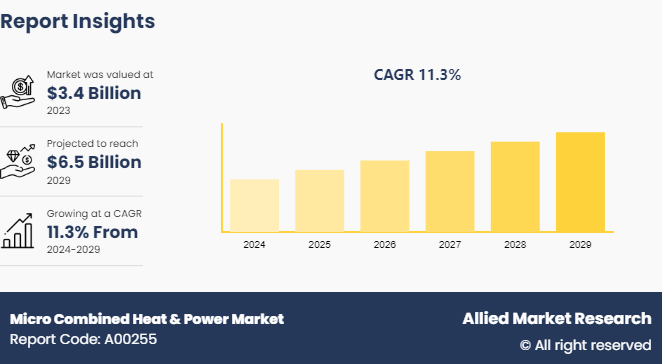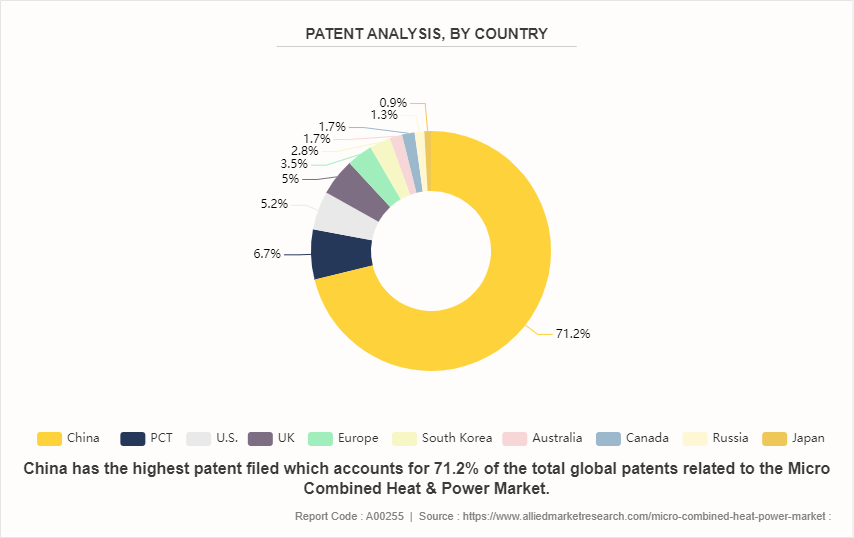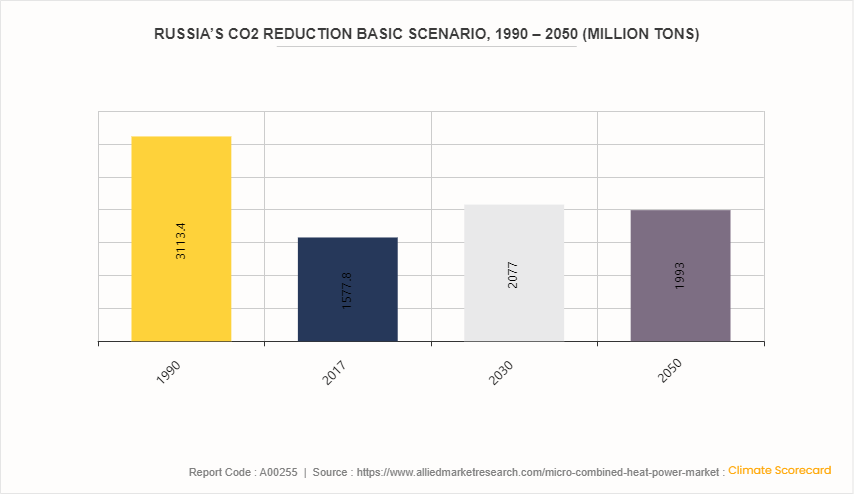Micro Combined Heat & Power Market
P
2024
Micro Combined Heat & Power Market Size, Share, Competitive Landscape and Trend Analysis Report, by Capacity, by Fuel Type by Prime Mover by Application : Global Opportunity Analysis and Industry Forecast, 2024-2029
Micro Combined Heat & Power Market Research, 2029
The global micro combined heat & power market was valued at $3.4 billion in 2023, and is projected to reach $6.5 billion by 2029, growing at a CAGR of 11.3% from 2024 to 2029.

Market Introduction and Definition
Micro combined heat and power (Micro CHP) systems are small-scale energy systems designed to simultaneously produce electricity and useful heat from a single fuel source. Typically used in residential or small commercial settings, these systems generate power through a prime mover, such as an internal combustion engine, fuel cell, or Stirling engine, which drives a generator to produce electricity. The heat generated from this process is captured and used for space heating or hot water, maximizing overall energy efficiency.
Micro CHP units offer several key benefits, including reduced energy bills, lower greenhouse gas emissions, and enhanced energy security by providing localized power generation. They are particularly efficient in applications with a consistent heat demand, as they utilize excess heat that would otherwise be wasted. The systems are compact, with many models designed to fit within standard residential spaces, and they can operate on various fuels, including natural gas, propane, and biofuels, offering flexibility in fuel choice and reducing reliance on external energy sources.
Key Takeaways
- The micro combined heat & power market report study covers 20 countries. The research includes a segment analysis of each country in terms of value ($Billion) for the projected period 2024-2029.
- More than 1,500 product literatures, industry releases, annual reports, and other such documents of major micro combined heat & power industry participants along with authentic industry journals, trade associations' releases, and government websites have been reviewed for generating high-value industry insights.
- The study integrated high-quality data, professional opinions and analysis, and critical independent perspectives. The research approach is intended to provide a balanced view of global markets and to assist stakeholders in making educated decisions to achieve their most ambitious growth objectives.
Key Market Dynamics
Government incentives and regulations are key drivers for the growth of the micro combined heat and power market. These systems, which simultaneously generate heat and electricity from a single fuel source, are highly efficient and environmentally friendly. Governments worldwide are promoting Micro CHP through various incentives such as tax credits, grants, and subsidies to encourage adoption and investment. For instance, in Europe and Japan, favorable regulatory frameworks and financial incentives have significantly boosted the market. Additionally, stringent emissions regulations are pushing industries and residential sectors to adopt cleaner energy solutions like Micro CHP. Policies aimed at reducing carbon footprints and enhancing energy efficiency are further propelling the market.
For example, the Government of Japan, in collaboration with the industry, launched the ENE-FARM deployment program for residential fuel cell micro combined heat and power systems. By 2021, this program achieved a milestone of 400, 000 units deployed across the country. Following Japan's success, other nations are also exploring this market. These factors, coupled with government initiatives, are expected to boost the market during the forecast period. Additionally, according to the U.S. Department of Energy, the Office of Energy Efficiency & Renewable Energy announced a $10 million investment in research and development for Micro CHP systems. This investment aims to support the electric grid in the United States and further promote the adoption of these efficient energy solutions.
The integration of renewable energy sources and advancements in technology are also supported by these incentives, making Micro CHP systems more accessible and cost-effective. As governments continue to focus on sustainable energy solutions to meet climate goals, the micro combined heat and power market market is expected to witness substantial growth, driven by these supportive policies and regulations.
The high initial investment required for micro combined heat and power systems is a significant barrier to market growth. Micro CHP systems, which generate both heat and electricity from a single fuel source, offer increased energy efficiency and reduced carbon emissions. However, their advanced technology and installation costs are substantial compared to traditional heating and power systems. This financial burden deters potential residential and commercial consumers, particularly in regions where government incentives or subsidies are limited or non-existent. Additionally, the complexity of integrating micro CHP systems into existing infrastructure can further escalate costs, requiring specialized knowledge and potentially leading to higher maintenance expenses. Despite the long-term savings and environmental benefits, the immediate financial outlay remains a critical impediment, slowing widespread adoption and market expansion. Addressing these investment challenges through supportive policies and financing solutions is essential for fostering growth in the micro combined heat and power market.
The integration of Smart Grid technology presents a lucrative opportunity for the growth of the micro combined heat and power market. Smart Grids, with their advanced communication and control capabilities, enable efficient energy distribution and real-time management of energy resources. This integration allows Micro CHP systems to operate more effectively, providing reliable and decentralized energy solutions that can balance supply and demand dynamically. Enhanced grid resilience, reduced energy losses, and increased energy efficiency are some benefits that Smart Grids bring to Micro CHP systems. Additionally, the ability to seamlessly incorporate renewable energy sources and support energy storage systems further enhances the appeal of Micro CHP solutions. As governments and utilities worldwide prioritize sustainable energy infrastructure, the synergy between Smart Grids and Micro CHP systems will drive significant market growth, offering cost savings, environmental benefits, and improved energy security.
Patent Analysis of the Global Micro Combined Heat & Power Market
In the micro combined heat & power market, China dominates patent activity with a substantial 71.2% share, indicating its leading position in technological advancements and innovations. The U.S. and the UK follow with 5.2% and 5.0%, respectively, reflecting their notable but less dominant roles. Europe and South Korea hold smaller shares, at 3.5% and 2.8%, respectively, highlighting their niche contributions. Countries like Australia and Canada contribute 1.7% each, while Russia and Japan contribute 1.3% and 0.9%, respectively. This distribution underscores China's significant role in driving the Micro CHP technology forward.

Market Segmentation
The micro combined heat & power market is segmented into capacity, fuel type, prime mover, application and region. Based on capacity, the market is classified into up to 2 KW, 2 KW to 10 KW and 10 to 50 KW. By fuel type, the market is divided into coal, renewable resources, oil and natural gas & LPG. As per prime mover, the market is divided into stirling engine, internal combustion engine, and fuel cell. By application, the market is divided into residential and commercial. Region-wise, the market is analyzed across North America, Europe, Asia-Pacific, and LAMEA.
Competitive Landscape
The major players operating in the micro combined heat & power market include YANMAR HOLDINGS Co., Ltd., General Electric, Siemens AG, 2G Energy AG, Axiom Energy Group, LLC., SAMAD POWER LTD, EC POWER A/S, Honda Motor Co., Ltd., BDR Thermea Group, and Vaillant Group.
Recent Key Strategies and Developments
- In September 2023, BDR Thermea Group acquired a 25 percent stake to enhance its strategic partnership with G.I. Holding, aiming to expand its range of energy transition solutions for commercial and industrial customers.
- In August 2023, 2G Energy expanded its core cogeneration business by acquiring Dutch heat pump manufacturer NRGTEQ. This addition aligns with the growing political focus on electrifying the heating sector, highlighting 2G Energy's commitment to offering diverse and sustainable energy solutions.
- In January 2022, Total Energy Systems, a provider of critical power solutions in the upper Midwest, announced its authorization as a distributor for Gridiron onsite power generation systems. Gridiron's products include the Power Plant H24 micro combined heat and power unit, which operates on renewable natural gas, natural gas, or propane.
- In September 2021, AFCP, a leading developer and manufacturer of micro-CHP systems, announced plans to start testing next-generation power units with Gaskatel GmbH. This collaboration aims to introduce micro-CHP systems based on hydrogen-powered alkaline fuel cell technology.
- In July 2021, Honda India Power Products Ltd—a subsidiary of Honda Motor Company—introduced a powerful 5.5HP power tiller designed to enhance farm productivity.
- In June 2021, Toyota City and AISIN partnered to promote household co-generation systems (ENE-FARM) using IoT technology. This project, a first in Japan, uses IoT to measure CO2 reduction and sell credits to local companies, fostering a green economic cycle.
- In March 2021, Yanmar Energy System Co., Ltd., a subsidiary of Yanmar Holdings, signed an agreement with 2G Energietechnik GmbH (2G) , a subsidiary of 2G Energy AG, to sell 2G's gas cogeneration systems. This effort supports the decarbonization of Yanmar. Additionally, Yanmar established the Carbon Neutral Business Promotion Office in Japan and Germany, focusing on the early commercialization of new fuels, such as hydrogen, to achieve decarbonization in Japan and abroad.
Regional Market Outlook
Asia-Pacific is experiencing robust economic growth. The increasing demand for micro combined heat and power in the Asia-Pacific region is driven by rising energy costs, growing environmental concerns, and government incentives for energy-efficient solutions. The rapid urbanization and industrialization in countries like China and India boost the need for reliable, decentralized power sources. Additionally, advancements in micro CHP technology, offering enhanced efficiency and reduced greenhouse gas emissions, further propel market growth, aligning with regional goals for sustainable energy and reduced carbon footprints.
- In Japan, fuel cell-based micro-CHP systems have become a popular choice for heat and electricity generation in residential and commercial sectors, including hotels, public facilities, hospitals, and institutions, due to their power-saving benefits and reliable energy supply. The sales of micro-CHP systems under the Ene-Farm program began in 2009, ahead of other countries.
- The shift towards grid-independent power generation, along with favorable government policies, is a major driver for the adoption of micro-CHP in Japan. Foreign Direct Investments and special measure laws for new energy use have been implemented to accelerate the growth of the CHP market in the country. In response to the Tohoku earthquake and Fukushima nuclear crisis, the Japanese government is promoting industrial CHP systems as a safer and cost-effective option for electricity generation. These factors significantly contribute to the growth of the micro-CHP market in Japan.
- Japan implemented the successful Ene-farm fuel cell commercialization program in 2015. By 2019, this program resulted in the deployment of approximately 306, 000 fuel cell-based micro-CHP systems, with about 90% installed in the residential sector. Each system has a capacity of up to 5 kW. The country aims to deploy around 5.3 million residential units by 2030.
- Similar to Japan, South Korea has been an early adopter of fuel cell-based micro-CHP systems. The installation of residential CHPs began as early as 2012, with around 350 micro-CHPs installed that year, and has continued to grow, supported by favorable government policies.
- According to the South Korean government's Hydrogen Economy Roadmap announced in 2019, South Korea plans to produce around 2.1 GW of micro fuel cells for households and buildings by 2040. This initiative is expected to significantly drive the micro-CHP market during the forecast period.
- Therefore, Asia-Pacific is projected to emerge as a dominant force in the micro combined heat & power market throughout the forecast period.
Increased Emphasis on Carbon Reduction is likely to Propel the Growth of the Micro Combined Heat and Power Market
The growth of the micro combined heat and power market is being propelled by a heightened focus on carbon reduction. Micro CHP systems offer significant environmental benefits by simultaneously generating heat and electricity from a single fuel source, leading to higher energy efficiency and reduced greenhouse gas emissions. This dual-generation capability aligns with global initiatives aimed at minimizing carbon footprints and promoting sustainable energy solutions. As governments and industries prioritize carbon reduction and implement stricter environmental regulations, the demand for Micro CHP systems is expected to surge, driving market expansion and technological advancements in the sector.
The socio-economic development strategy of Russia until 2050, formulated by the Ministry of Economic Development, outlines four scenarios: basic, intensive, inertial, and one without state support measures. According to the basic scenario, Russia aims to cut the carbon intensity of GDP by 9% by 2030 and reduce greenhouse gas emissions by one-third by 2030 compared to 1990 levels. Under this scenario, Russia plans to decrease its greenhouse gas emissions by 36% by 2050 from 1990 levels, achieving a target of 2 billion tons of CO2 equivalent. This would result in a total cumulative reduction in emissions of 80-81 billion tons.

Industry Trends
- The increasing demand for micro combined heat and power in residential applications is driven by rising energy costs, the push for energy efficiency, government incentives, and the need for reduced carbon emissions. Micro CHP systems offer reliable, on-site electricity and heat production, appealing to eco-conscious homeowners and cost-savvy consumers.
- Micro-CHP systems' compact size makes them ideal for sectors with lower energy demands, like domestic households. These systems can cut fuel consumption, leading to lower emissions and costs. Smaller micro-CHP units boast high capacity factors (up to 95%) and can run on traditional fuels like natural gas, LPG, or oil, as well as low-carbon alternatives like biogas, RNG, hydrogen, or biodiesel.
- Residential micro-CHP systems offer a localized energy source, enhancing resiliency for remote homes and communities prone to power outages from grid failures or severe natural disasters.
- A significant benefit of micro-CHP systems in residential settings is their minimal space requirement, as they are comparable in size and shape to standard residential boilers, allowing for wall or floor mounting. While the initial cost of a residential micro-CHP system is higher than that of a similar-sized steam boiler system, installation processes and costs are similar. Additionally, maintenance and service costs are comparable to standard boilers, although skilled specialists are needed for micro-CHP systems.
- Due to existing natural gas infrastructure, micro-CHP systems have been most successful in high-income countries with cold winters, such as Europe and Japan. In contrast, the market in countries like Canada, the U.S., and China has grown moderately over recent years, driven by a few pilot projects at the residential level.
- In the U.S., several federal and state-level incentives, including grants, tax credits, and financing from various governmental schemes, along with net metering policies for residential micro-CHP users, support the market. Despite limited deployment, there is considerable potential in the U.S., where the residential sector comprises 122 million households and accounts for 21% of the nation's total energy consumption. With many families relying on traditional systems like conventional boilers and the grid, micro-CHP systems present an economical, efficient, and resilient alternative.
Key Sources Referred
- Invest India
- IEA
- South Korean Government's Hydrogen Economy Roadmap
- International Energy Agency (IEA)
- The U.S. Department of Energy
- Ministry of Economic Development
Key Benefits For Stakeholders
- This report provides a quantitative analysis of the market segments, current trends, estimations, and dynamics of the micro combined heat & power market analysis from 2024 to 2029 to identify the prevailing micro combined heat & power market opportunities.
- The market research is offered along with information related to key drivers, restraints, and opportunities.
- Porter's five forces analysis highlights the potency of buyers and suppliers to enable stakeholders make profit-oriented business decisions and strengthen their supplier-buyer network.
- In-depth analysis of the micro combined heat & power market segmentation assists to determine the prevailing market opportunities.
- Major countries in each region are mapped according to their revenue contribution to the global market.
- Market player positioning facilitates benchmarking and provides a clear understanding of the present position of the market players.
- The report includes the analysis of the regional as well as global micro combined heat & power market trends, key players, market segments, application areas, and market growth strategies.
Micro Combined Heat & Power Market Report Highlights
| Aspect | Details |
|---|---|
Market Size By 2029 | USD 6.5 Billion |
Growth Rate | CAGR of 11.3% |
Forecast period | 2024 - 2029 |
Report Pages | 350 |
By Capacity |
|
By Fuel Type |
|
By Prime Mover |
|
By Application |
|
By Region |
|
Key Market Players | General Electric , YANMAR HOLDINGS Co., Ltd., Honda Motor Co., Ltd. , Vaillant Group, Siemens AG, EC POWER A/S, Axiom Energy Group, LLC., BDR Thermea Group, 2G Energy AG, SAMAD POWER LTD |
Related Tags
Combined Heat and PowerIndustrial HeatingFrequently Asked Questions?
The residential is the leading application of Micro Combined Heat & Power Market.
Asia-Pacific is the largest regional market for Micro Combined Heat & Power.
YANMAR HOLDINGS Co., Ltd., General Electric, Siemens AG, 2G Energy AG, Axiom Energy Group, LLC., SAMAD POWER LTD, EC POWER A/S, Honda Motor Co., Ltd., BDR Thermea Group, and Vaillant Group are the top companies to hold the market share in Micro Combined Heat & Power.
Energy efficiency and cost savings and rising energy costs are the drivers of Micro Combined Heat & Power Market in the globe.
The micro combined heat & power market was valued at $3.4 billion in 2023 and is estimated to reach $6.5 billion by 2029, exhibiting a CAGR of 11.3% from 2024 to 2029.

